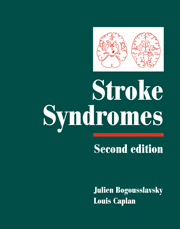Book contents
- Frontmatter
- Contents
- List of contributors
- Preface
- PART I CLINICAL MANIFESTATIONS
- PART II VASCULAR TOPOGRAPHIC SYNDROMES
- 29 Arterial territories of human brain
- 30 Superficial middle cerebral artery syndromes
- 31 Lenticulostriate arteries
- 32 Anterior cerebral artery
- 33 Anterior choroidal artery territory infarcts
- 34 Thalamic infarcts and hemorrhages
- 35 Caudate infarcts and hemorrhages
- 36 Posterior cerebral artery
- 37 Large and panhemispheric infarcts
- 38 Multiple, multilevel and bihemispheric infarcts
- 39 Midbrain infarcts
- 40 Pontine infarcts and hemorrhages
- 41 Medullary infarcts and hemorrhages
- 42 Cerebellar stroke syndromes
- 43 Extended infarcts in the posterior circulation (brainstem/cerebellum)
- 44 Border zone infarcts
- 45 Classical lacunar syndromes
- 46 Putaminal hemorrhages
- 47 Lobar hemorrhages
- 48 Intraventricular hemorrhages
- 49 Subarachnoid hemorrhage syndromes
- 50 Brain venous thrombosis syndromes
- 51 Carotid occlusion syndromes
- 52 Cervical artery dissection syndromes
- 53 Syndromes related to large artery thromboembolism within the vertebrobasilar system
- 54 Spinal stroke syndromes
- Index
- Plate section
35 - Caudate infarcts and hemorrhages
from PART II - VASCULAR TOPOGRAPHIC SYNDROMES
Published online by Cambridge University Press: 17 May 2010
- Frontmatter
- Contents
- List of contributors
- Preface
- PART I CLINICAL MANIFESTATIONS
- PART II VASCULAR TOPOGRAPHIC SYNDROMES
- 29 Arterial territories of human brain
- 30 Superficial middle cerebral artery syndromes
- 31 Lenticulostriate arteries
- 32 Anterior cerebral artery
- 33 Anterior choroidal artery territory infarcts
- 34 Thalamic infarcts and hemorrhages
- 35 Caudate infarcts and hemorrhages
- 36 Posterior cerebral artery
- 37 Large and panhemispheric infarcts
- 38 Multiple, multilevel and bihemispheric infarcts
- 39 Midbrain infarcts
- 40 Pontine infarcts and hemorrhages
- 41 Medullary infarcts and hemorrhages
- 42 Cerebellar stroke syndromes
- 43 Extended infarcts in the posterior circulation (brainstem/cerebellum)
- 44 Border zone infarcts
- 45 Classical lacunar syndromes
- 46 Putaminal hemorrhages
- 47 Lobar hemorrhages
- 48 Intraventricular hemorrhages
- 49 Subarachnoid hemorrhage syndromes
- 50 Brain venous thrombosis syndromes
- 51 Carotid occlusion syndromes
- 52 Cervical artery dissection syndromes
- 53 Syndromes related to large artery thromboembolism within the vertebrobasilar system
- 54 Spinal stroke syndromes
- Index
- Plate section
Summary
Introduction
Recent advances in brain imaging have made it possible to study clinical, cognitive, and behavioural abnormalities of caudate vascular lesions. Most of the major studies on caudate vascular lesions followed the introduction and widespread use of CT scanning in the 1970s and early 1980s. There are only a few studies of the vascular lesions, either infarcts or hemorrhages, involving the caudate nucleus. Most studies included caudate lesions involving the neighbouring structures like the putamen, internal capsule, and white-matter (Damasio et al., 1982; Richfield et al., 1987; Alexander et al., 1987; Mehler, 1987; Mendez et al., 1989; Caplan et al., 1990; Cambier et al., 1979; Valenstein & Heilman, 1981; Weisberg, 1984; Stein et al., 1984; Waga et al., 1986; Pozzilli et al., 1987; Pedrazzi et al., 1990). Recently Kumral et al. studied a series of patients with caudate infarcts or hemorrhages involving the head of the caudate nucleus (confirmed by CT and MRI), and discussed the stroke etiologies, clinical profiles, and behavioural abnormalities (Kumral et al., 1999).
Anatomy of the caudate nucleus
Functional neuroanatomy: ‘parallel frontal–striatal–thalamic–frontal circuits’
According to Alexander et al.(1986) in the striatum including the caudate nucleus there are at least five parallel functionally segregated circuits that link the basal ganglia with the motor, associative, and limbic cortices. Each circuit is defined by the area of cerebral cortex projecting to specified regions of the striatum, and by the corresponding return thalamo-cortical projection to specified areas of frontal cortex. The circuits remain more or less segregated throughout the basal ganglia and thalamus and there are cross-links between them at various relays therein. Within each circuit, the basal ganglia execute a similar, common function.
- Type
- Chapter
- Information
- Stroke Syndromes , pp. 469 - 478Publisher: Cambridge University PressPrint publication year: 2001

